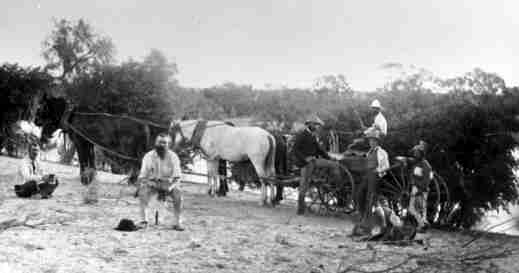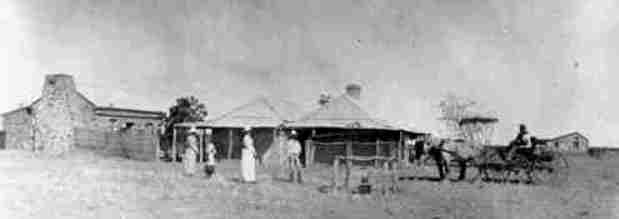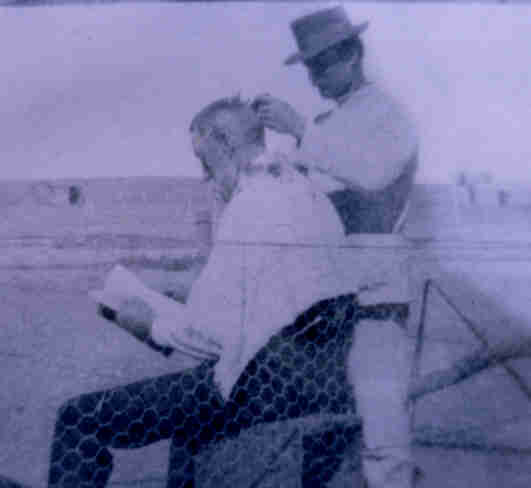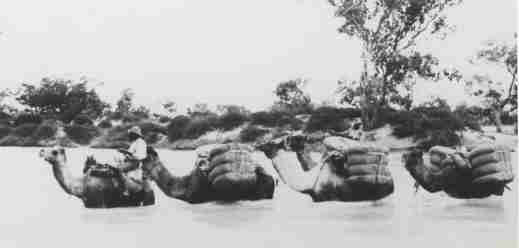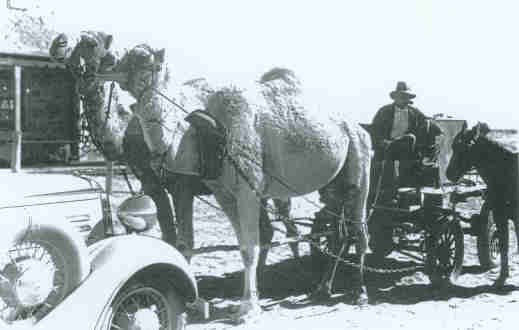


|
Tinga Tingana StationPart 2At the start of 1892 several of the far northern leases were advertised in the local papers, including the German newspaper Australische Zeitung. In April it was reported that 'Many a lessee in the North-East is simply holding on longing for the expiry of his lease to get the cash, and with runs almost unstocked, save by vermin, would have gone long since had the improvements belonged to the Crown. Tinga Tingana on the Strzelecki Creek, recently let as a miscellaneous lease after hanging on the hands of the Government for many months, is a case in point. The late lessee would not have accepted an extension of tenure on any terms. The improvements were paid for by the Government. Being unoccupied they speedily went to ruin. The Government had a caretaker employed to protect them, but even then, the spread of vermin, resulting in terrible depreciation of the country, could not be stopped. Ultimately the Government were glad to accept an almost nominal rent for the run to get it off their hands, and only special circumstances led to the taking of it then.
There is nothing at present beyond the nominal deposit of 10 per cent, on the value of the improvements, which deposit is returned to the lessee as soon as he shall have made new improvements on the land equal in value to the amount of the deposit, to make the lessee share the interest, the maintenance of the improvements with the Government. A number of lessees have applied to the Government for information as to the length of new leases they can obtain, and the rent they will be expected to pay, but it is understood that so far, no lessee has accepted the terms offered, so that the object of reducing the liability of the Crown for improvements has not been accomplished. It is not very cheering to find that the latest endeavour of Parliament to perfect the pastoral land laws has resulted so unsuccessfully. It is, perhaps, only necessary to point out that what has now been referred to is purely pastoral land laws. The law affecting the Fringe country between the pastoral lands and the farm lands is dealt with by the Land Boards, either on perpetual lease or on leases with right of purchase, and the improvements belong to the occupiers.' During July 1894, Tinga Tingana recorded 2.5 inches of rain which may have done a lot of good but by November JC Warren reported a large increase in rabbits. Six months later the country was 'absolutely destitute of vegetation' and once more deserted, but the government had put in a caretaker. A year later it was stated that the lease of 1291 square miles had improvements worth just over 3,000 pounds. By October 1895 even the Aborigines were starving. As the caretaker had died no rations were forwarded by the government. When a new caretaker was appointed, it had been too late for some of the suffering native population. According to JC Warren 'the Strzelecki road is, I fear, hopelessly ruined, and a similar fate must soon befall the Birdsville track; for once the rabbits get into sandy country nothing else can exist, as they destroy the natural herbage and bush, and a good rain brings up little else but poison weed'.
A year later John Henry Wilson was found guilty of stealing 6 bullocks from the station, which now belonged to the Beltana Pastoral Company, and sentenced to three years imprisonment with hard labour. Finally, some good rains fell in late 1896 and early 1897. It was too late for Samuel Watts, who died during the heat wave. Soon there was enough feed and water for farmers to take up horses from Bendleby, Hawker, Carrieton and Orroroo to the still unoccupied stations like Tinga Tingana. In September 1898, RJ Graham reported that at the police camp at Tinga Tingana he saw Logic, 'the 'nigger' who had gained notoriety by killing a stockman on the Cooper, and afterwards the sympathy of the public and his freedom by a plucky attempt to escape from the Adelaide Goal'.
One wonders if Graham was aware of the fact that the Chronicle of 23 January 1886 had reported that the Aborigine Logic, who had been spending a few days with Inspector Besley, sub-protector of Aborigines, 'left Port Augusta by train on Thursday morning for Beltana, from which place he will walk to Tinga Tingana. He has been presented by the Government with a new pair of moleskin trousers, a blue shirt, and a water bag, and his swag contains the usual assortment of aboriginal etceteras, with a few trifles calculated to alleviate the ennui of savage life'. Tinga Tingana was still unoccupied and looked after by a government caretaker. In 1899 George Pearce became caretaker and stayed for some time. On 8 August 1902 Frederick Lloyd Herbert Oliffe was born at the station. He later married, moved to Western Australia and joined the Citizen Military Forces during WWII. It was not until 1906 that Tinga Tingana was taken up by MR Oates. JW Mansfield, storekeeper of Farina, had a large caravan of camels loaded with stores for the station, which was referred to as 'the abomination of desolation,' and also for Innamincka and Haddon Downs. Camels were still being used in the far north and would be until the late 1920s. By that time, they had become a nuisance and were often shot in large numbers. After 1910, conditions improved markedly as rain was recorded which even resulted in the occasional flood. In April 1912 Albert Pope bought 250 head of cattle for Tinga Tingana and reported that his part of the country was looking splendid. Albert was the son of George Pope who had arrived in South Australia in 1847. For several years he had carted for the Callington and Kanmantoo mines. He later moved to the Burra mines and eventually to Blinman. Albert followed in his father's footsteps and started driving the Birdsville Track delivering the mail for his wife's uncle August Helling. He left Marree, his place of residence, and settled at Kopperamanna Bore. In 1900 the family of eight moved to Innamincka where Albert became the publican. The hotel wasn't really a money spinner and after extensive damages caused by the floods in 1906 and 1907 the family moved once again, this time to Tinga Tingana. In 1914 Tinga Tingana station was owned by Sidney Kidman and JAD Patterson. Conditions were good enough for Captain White to conduct a scientific expedition in the area. In his report he later wrote; 'We were now on Mr JAD Patterson's handy little run, Tinga Tingana. Following the course of the creek, we found the timber was improving in size, appearing wherever large waterholes existed, and upon the trunks of some of them old scars were plainly seen where, the wild blacks of long ago cut notches to assist them in ascending the trees in search of opossums, eggs, or young birds. We all at once emerged from the thick timber in the dry watercourse upon the station house of Tinga Tingana, a comfortable dwelling, built upon the bank of the creek. Here we halted for half an hour to purchase meat, and Mrs Patterson most kindly gave us a cup of tea, which we greatly enjoyed. Having procured the meat required, we moved on for a mile or so, and camped on the bank of a fine waterhole, where we saw a number of birds, among them the large black cormorant and the white-necked heron. The day was close and the weather looked so threatening that we expected rain to set in at any moment, but we pushed on, hoping to make the next waterhole, seven miles further on, before dark. Shell parrots were congregating in great numbers all along the timbered creek, and would soon begin to be active over domestic duties. Walking along some distance in front of the camels, I occasionally looked back at the great black mass of clouds rolling up behind us, and wondered if we would reach the waterhole before the storm burst. About 4.30 (it seemed much later on account of the dark sky) I saw the welcome waterhole glistening amid the timber a few hundred yards off our track, and just then large drops of rain began to fall. A fairly elevated piece of ground was close at hand, where we could make camp, so the camels were put dawn and unloaded, tents hurriedly pitched, stores and camel saddles stacked, and a large tarpaulin thrown over them, but before this work was accomplished rain was steadily falling, and so was the temperature'. Conditions remained favourable for some years and in March 1917 Mrs and Miss Patterson went to Broken Hill for a short visit. On 11 November that year Archibald, father of John, died at Tinga Tingana aged 94 leaving one son and four daughters to mourn their loss.
A pretty wedding took place at Tinga Tingana Station on Tuesday, January 13, 1925, the occasion being the marriage of Mr John Archibald Thomas. He was born in 1900 at Wilcannia and became a mail contractor in 1924. He was the eldest son of Mr John and Mrs Patterson, of Tinga Tingana station, and was married to Evelyn Matilda May, eldest daughter of Mr and Mrs Barwis, of Marree. The Rev. J Emery, of Blinman, conducted the service. Among those present were Mr AH and Mrs Rowland and family, of Innamincka Station, Miss Sarah Patterson (aunt), Misses A Pope, E Hawson and OW Skipper. Misses Kathleen and Alice Patterson (sisters of the bridegroom) were bridesmaids and Mr E Hawson was best man. In the absence of the bride's parents, Mr OW Skipper gave the bride away. After the ceremony the wedding cake was cut and was accompanied with some excellent wine, and the pleasant little gathering in the heart of Australia were entertained by Mrs Patterson, Sen., in hospitable fashion. In the evening there was dancing. In the middle of one dance a terrific thunderstorm broke over the homestead, accompanied by very heavy rain. Over an inch fell in one shower, and the place was soon surrounded by small lakes of fresh rainwater, while tanks were overflowing. The dance, however, continued. Towards the early hours of Wednesday morning (January 14) more rain fell, and by 8 a.m. 186 points had been registered.
This was John Archibald Patterson's home before he moved to Farina to take over the Farina Hotel. From left: John Patterson's daughter-in-law, Evelyn Patterson with baby Evelyn, his sister Sarah Patterson, and his daughters Alice and Catherine Patterson. John's father, Archibald Patterson, died there in 1917. The men on the station, poured a concrete headstone, then with pocket knives carved letters and numbers out of lead and placed them in the concrete. Then in blacksmith's shop forged a fence to enclose the grave.(SLSA) Good rains were also reported for 40 miles to the south and for many miles north. Creeks were running, and the country soon wearing a green and fresh appearance, giving hope of a good season and a happy married life. Nearly three years later, on 19 December 1927, James Davey of Waukaringa and Catherine Eliza Patterson were married at the All Saints' Church at Farina.
Unfortunately, it seemed that all good things come to an end as in 1932 Ernestine Hill, well-known author and journalist, wrote; It is a sad pilgrimage now, a trail of skeletons. On the bank of the Strzelecki lie the sand-swept ruins of four stations that only 10 years ago were hopeful and prosperous, running their tens of thousands of sheep and cattle. The first is Carrawina, with an empty, tumble-down homestead, and 60,000 pounds worth of fences engulfed, where five years ago the cattle died in their thousands on the salt wells and the creeks. There are Tinga Tingana and Merty-Merty, that once proudly vaunted orange gardens and grape vines, both homesteads buried deep in the drought sands, and Talachi, with the last few remnants of its herds not worth mustering. On the way through the mail passes Nappacoongi, a ruined well, that some years ago fell in upon an unfortunate who had gone down to repair it. Without even a last call to his mates this man went to his death, and the broken well stands as his sepulcher. Among some of the books she wrote are; My Love Must Wait, Water into Gold, The Northern Territory, Kabbarli, a personal memoir of Daisy Bates and the Great Australian Loneliness. With the death of William Clarence Burkitt, born at Tinga Tingana and late manager of Newcastle Waters in March 1937, age 62, Tinga Tingana disappeared from news. please go to home page for more information. Thank you for visiting South Australian History, We hope you enjoy your stay and find the information useful. This site has been designed and is maintained by FRR.
|
